
Amazon SEO: The Ultimate Guide to Higher Product Ranking (With Tips & Examples)
Robin Hanna, January 10, 2018
Table of Contents
Amazon SEO (search engine optimization) is the process of optimizing Amazon product listings to rank higher in Amazon search results for relevant keywords.
So, if you want to increase your sales on Amazon using search engine optimization techniques, you’ve come to the right place! In this comprehensive step-by-step Amazon SEO guide we’ll cover:
PART 1 (Theory): Understanding Amazon SEO
PART 2 (Hands-on): How to optimize your product listing for Amazon SEO
Step-by-step instructions to optimize your products, including:
Note that Amazon continually changes its algorithm.
But don’t worry: we always update this guide as soon as there are changes to the algorithm so you can be sure that it’s up-to-date and includes the latest insights.
If you’re not sure whether you need SEO, PPC, or both — we recommend you start with this post and our free Benchmarker tool.
Let’s get started.
Top sellers use cutting-edge advertising tools
Perpetua offers the most advanced Amazon PPC solution on the market, with all the tools, resources, and expert support you need to build successful campaigns for your products. And what’s more, it couldn’t be easier to get started. Request a free demo today to discover the industry’s premier optimization and intelligence software for Amazon Ads.
PART 1: Understanding Amazon SEO and the Amazon Ranking Algorithm (A9)
In the first part of this guide, we look at the theoretical side of Amazon SEO and the A9 algorithm at its core. If you can't wait to get your hands dirty, you can jump straight into the practical side of optimization, which is covered in depth in section B.
What is Amazon SEO?
Amazon SEO is the practice of optimizing your Amazon product listings with the aim of improving your organic rankings in Amazon's search results. These better rankings lead to increased visibility for your products (measured by more impressions), which should result in more clicks and, ultimately, more sales.
Just like on Google, buyers on Amazon enter a keyword to find what they are looking for and just like on Google, users mainly click on the first few results and rarely click on a product on the second, third, or any further page.
What is an organic search result?
When we're talking about Amazon SEO, we're focusing on the organic search results. These are the product listings that are NOT paid for i.e. these are not ads. Organic search results are therefore not selected by any auction or by a seller's bidding power, but by what Amazon's algorithm deems most relevant for the search term entered by the user.
If you’re selling on Amazon, the concentration of clicks on the top results means that the rankings on Amazon are the most important success factors for your business: the higher you rank, the more you sell!
If you rank on page 3 or lower, you’re unlikely to sell anything. On top of that, more than 66% of shoppers now start their search for new products on Amazon. That means: if your products are not ranking well in the Amazon search results, you’re really missing out on sales potential!
The ranking of a product is determined by an algorithm called “A9” (A is shorthand for “algorithm” and the 9 simply refers to the 9th generation.) As this algorithm basically decides the fate of your success on Amazon, it’s a good idea to understand it a little better.
Top sellers use cutting-edge advertising tools
Perpetua offers the most advanced Amazon PPC solution on the market, with all the tools, resources, and expert support you need to build successful campaigns for your products. And what’s more, it couldn’t be easier to get started. Request a free demo today to discover the industry’s premier optimization and intelligence software for Amazon Ads.
How does the Amazon ranking algorithm (A9) work?
With millions of products to choose from, buyers perform hundreds of millions of search queries on Amazon every month.
For every single search query, Amazon needs to decide — within a few milliseconds — which one of the hundreds of millions of products it will show on ranking position number 1, number 2, etc.
Which factors does Amazon take into account to solve this very complex challenge?
Amazon ranks products based on purchase likelihood
Three parties come together on Amazon: a buyer, a seller, and Amazon.
Shoppers come to Amazon for only one reason: they want to buy! This search intent represents an important contrast to the mechanics of Google.
When a user types “iPhone” into Google, it’s unclear what this user is looking for. The user might want to buy an iPhone, but they might also just be looking for information about an iPhone or for an image to use in a presentation. Commonly, search intent on Google is described as falling into one of three main categories:
informational: the user is looking for information or the answers to questions (e.g., what is Amazon SEO?)
transactional: the user wants to make a purchase (e.g., buy iPhone)
navigational: the user knows which website they want to visit (e.g., facebook login)
On Amazon, there is only one intent behind every search query: transactional, as users are on Amazon because they want to buy a product.
Sellers also use Amazon for one reason only: they want to sell!
Finally, Amazon wants to generate revenue, but Amazon will only make money if a sale takes place (Amazon receives a 15% commission from a seller or collects the margin from a vendor).

All three parties (buyers, sellers, and Amazon) share a common goal: they all want a transaction to take place!
Amazon’s goal, therefore, is to build an algorithm that increases the number of transactions. To achieve this, Amazon's aim is to place the product that shoppers are most likely to buy on rank #1, the second most likely on rank #2, and so on — for every single search query.
In other words: Amazon wants to rank all products by purchase likelihood.
Top sellers use cutting-edge advertising tools
Perpetua offers the most advanced Amazon PPC solution on the market, with all the tools, resources, and expert support you need to build successful campaigns for your products. And what’s more, it couldn’t be easier to get started. Request a free demo today to discover the industry’s premier optimization and intelligence software for Amazon Ads.
Keywords and performance determine Amazon rankings and purchase likelihood
Amazon ranks products by purchase likelihood. That leaves us with the question:
How does Amazon determine purchase likelihood?
It appears to happen within seconds for the user, but behind the scenes, the verification of purchase likelihood is a very complex challenge.
Remember: there are hundreds of millions of products and hundreds of millions of search queries. The purchase likelihood of a product varies for every search query.
For example, an iPhone might have a very high purchase likelihood for the search query “iPhone”, but the same iPhone will have a significantly lower purchase likelihood for the search query “smartphone”.
As a consequence, Amazon has to determine the purchase likelihood not just for every product, but for every combination of product and search query.
To tackle this challenge and rank products, Amazon follows a two-step process.
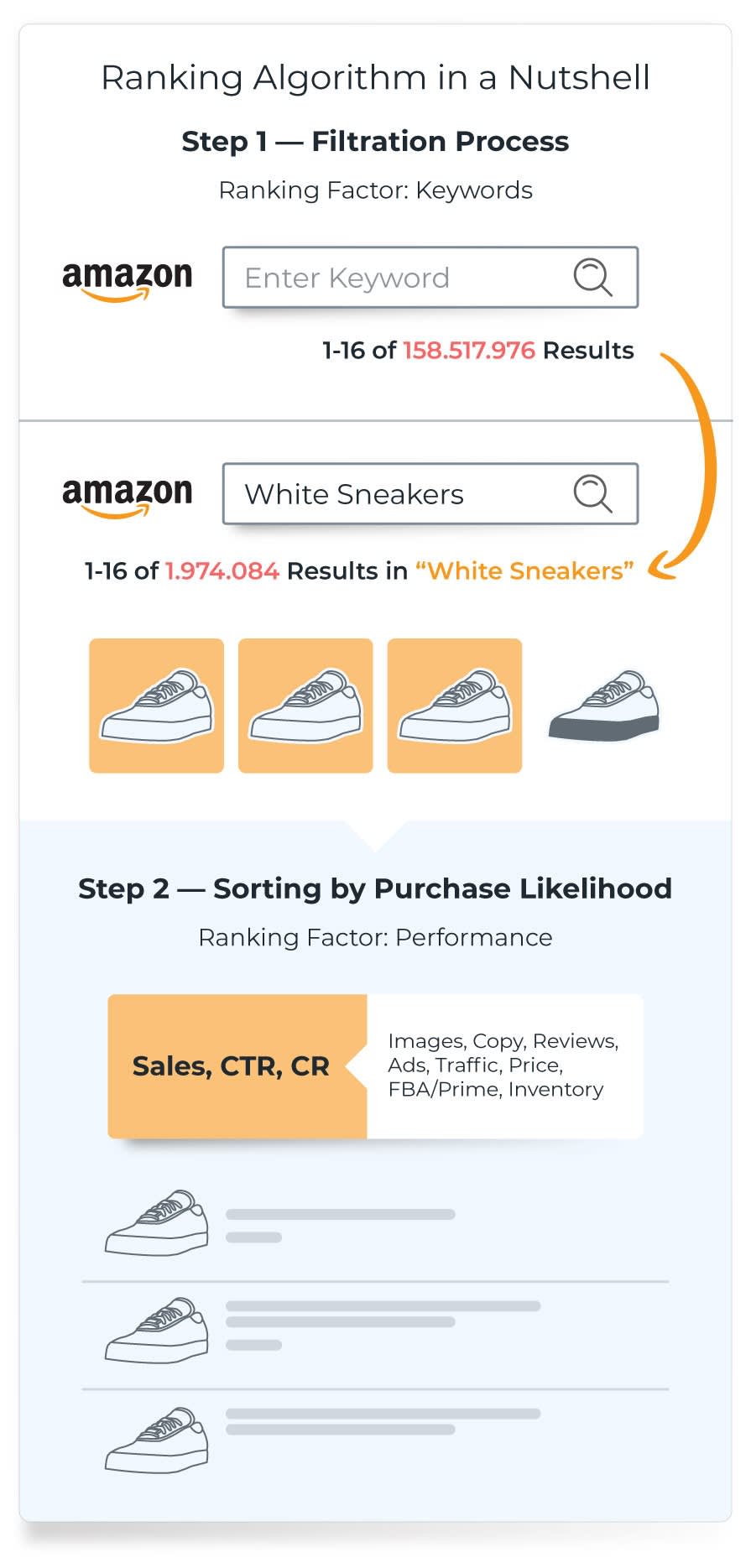
Step 1: Keywords determine if your product ranks on Amazon at all
In the first step, Amazon filters out all products that are not relevant for the customer search query — by looking at the keywords.
If a product does not contain all keywords of the search query, it cannot appear in the search results (you see why it’s critical that you add all relevant keywords to your product — but more on this later in the “keyword optimization” section).
This step is also technically important because it drastically reduces the number of products that Amazon needs to sort by purchase likelihood.
Top sellers use cutting-edge advertising tools
Perpetua offers the most advanced Amazon PPC solution on the market, with all the tools, resources, and expert support you need to build successful campaigns for your products. And what’s more, it couldn’t be easier to get started. Request a free demo today to discover the industry’s premier optimization and intelligence software for Amazon Ads.
Step 2: Performance determines how high your product ranks on Amazon (on which position)
In the second step, Amazon determines the purchase likelihood for the remaining products and ranks them in a specific order (a.k.a the Amazon ranking). To do this, Amazon looks at the performance of the products.
Performance is measured by click-through rate in search result, conversion rate on the product page, and especially sales. These are significant KPIs for Amazon as they represent the steps that users need to take to buy a product.
Amazon looks at these KPIs on a keyword-specific level: an iPhone, for example, will have different click-through rates, conversion rates, and sales for the keywords “iphone” and “smartphone”.
For you, this means: the better your click-through rate, conversion rate, and sales are for a specific keyword, the higher your product will rank for this keyword.
To actively increase your click-through rate, conversion rate, and sales and improve your rankings you can use a variety of levers, such as product images, copy, review management, and, importantly, Amazon PPC. More on this in the section “How to optimize your product listing.”
Click-through rate or conversion rate problem?
With the free Benchmarker, you can see exactly which products are getting clicks, but not converting. Additionally, you can also see how each product’s KPIs compare with other sellers in your category and marketplace. Get the insights you need to take your Amazon PPC performance to the next level. Try the free Benchmarker today!
Amazon SEO strategy and the Amazon marketing flywheel
Once people find your product and consider it relevant, they’ll probably click and buy it. The more people click and buy your product, the more generously the A9 algorithm will rank it. The higher your product ranks, the more people will buy it.
This momentum will, in turn, increase your rankings and even enable you to put more resources into marketing initiatives to drive your sales.
Top sellers use cutting-edge advertising tools
Perpetua offers the most advanced Amazon PPC solution on the market, with all the tools, resources, and expert support you need to build successful campaigns for your products. And what’s more, it couldn’t be easier to get started. Request a free demo today to discover the industry’s premier optimization and intelligence software for Amazon Ads.
This process and strategy can form a self-perpetuating flywheel between rankings, sales, and marketing initiatives that improves your sales.

You can feed this flywheel by channeling your profits into more marketing initiatives.
Crucially, increased sales contribute to improved rankings even if the sales come from paid ad clicks. This means that successful Amazon advertising campaigns directly help your organic rankings. Even with the best SEO efforts in the world, you will struggle to compete if you neglect the Amazon PPC channel.
PART 2: Step-By-Step Guide to Optimize Your Amazon Product Listings for Higher Rankings
Now that you’ve seen how the Amazon ranking algorithm (A9) works, let’s get our hands dirty and take a look at what you can do to optimize your product listing.
We’ll cover every step you need to take from creating your listing to making sure it climbs to the top after it’s live — and then stays there. Remember, Amazon is an ever-changing landscape with new products being launched, new sellers entering the marketplace, and new strategies being developed. So being top of the search results once doesn't mean you'll be top forever.
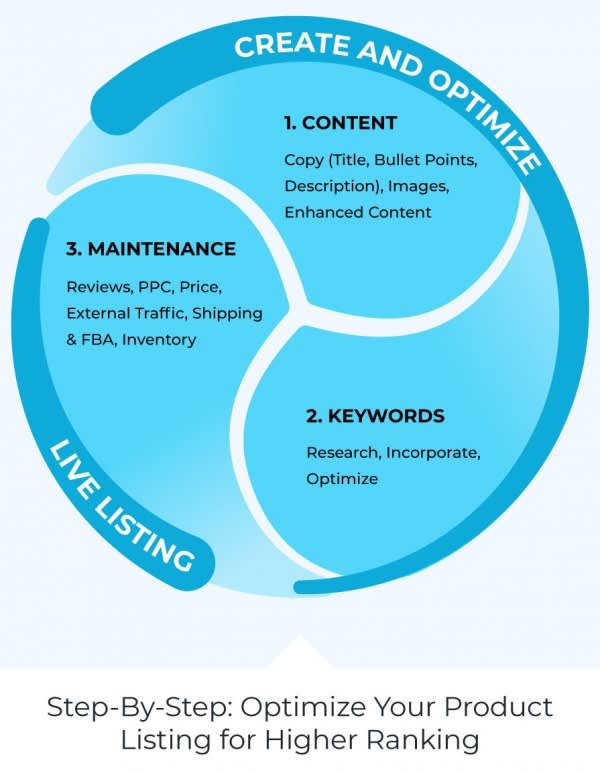
Keywords: Adding and optimizing the keywords of your listing
Maintenance: Ongoing optimization after the listing is live (e.g., managing reviews and leveraging Amazon PPC to improve your rankings)
Anyone who has worked on Google search engine optimization may be wondering why there is no mention here of technical Amazon SEO. The main reason is that on Amazon, there is a shared technical infrastructure for all product pages, so there isn't the same scope for technical optimization as there is in Google search, where each site owner has complete control.
Top sellers use cutting-edge advertising tools
Perpetua offers the most advanced Amazon PPC solution on the market, with all the tools, resources, and expert support you need to build successful campaigns for your products. And what’s more, it couldn’t be easier to get started. Request a free demo today to discover the industry’s premier optimization and intelligence software for Amazon Ads.
Anatomy of an Amazon product listing page
Before you start optimizing your Amazon product listing, let's take a quick look at the anatomy of an Amazon product page. In particular, your product page will be presented to the user in two main contexts:
The product preview in the search results (this is also how any Amazon Sponsored Products ads for your product will be displayed)
The product page itself.
The information displayed in these two places comes from the same source, but the impact is very different.
Amazon functions like other search engines, so the first window users have into your content is the product preview displayed on the search results page (SERP). Optimizing the content of your product listings that appears in these previews will improve your click-through rate in the search results.
After clicking, the user is taken to your product page, where much more content is visible to the user. Optimizing this information will encourage users to add the product to their basket and increase your conversion rate. Both click-through rate and conversion rate boost sales and, therefore, improve your product's ranking.
For those familiar with Google SEO, Amazon's product preview is the equivalent of the snippet in the Google SERP, while the product page is the landing page itself. Unlike Google, Amazon can monitor exactly what happens after a user visits the product page, which is one of the main reasons for the differences between Amazon's and Google's search algorithms.
Product preview
The screenshot shows the main elements of the product preview over which the seller has control:
product title
star rating and number of reviews
price
main product image.

Example of product preview showing product titles, star ratings and review counts, prices, and main product images.
What is most evident, particularly for those familiar with Google SEO, is that there is no meta description in the product preview. The only space for text content, and therefore keywords, is in the product title.
Top sellers use cutting-edge advertising tools
Perpetua offers the most advanced Amazon PPC solution on the market, with all the tools, resources, and expert support you need to build successful campaigns for your products. And what’s more, it couldn’t be easier to get started. Request a free demo today to discover the industry’s premier optimization and intelligence software for Amazon Ads.
Product detail page
In addition to the elements visible in the product preview, the Amazon product detail page also contains the following:
brand/manufacturer
bullet points
additional product images
product information
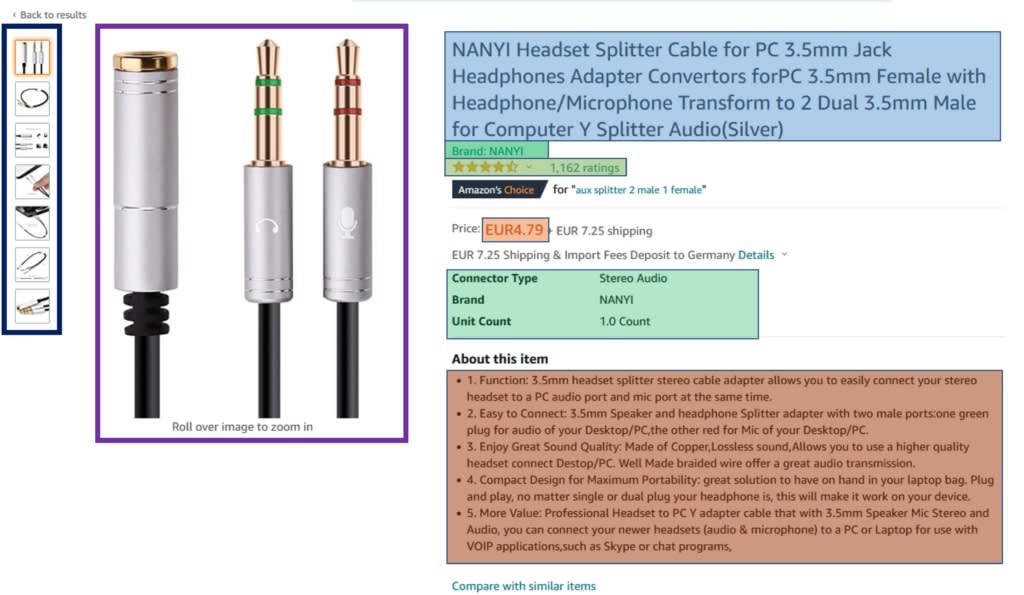
Product detail page showing title, brand, star rating and review count, price, main image and additional images, product information, and bullet points.
Scrolling down the page, there is further product information and a more lengthy product description:
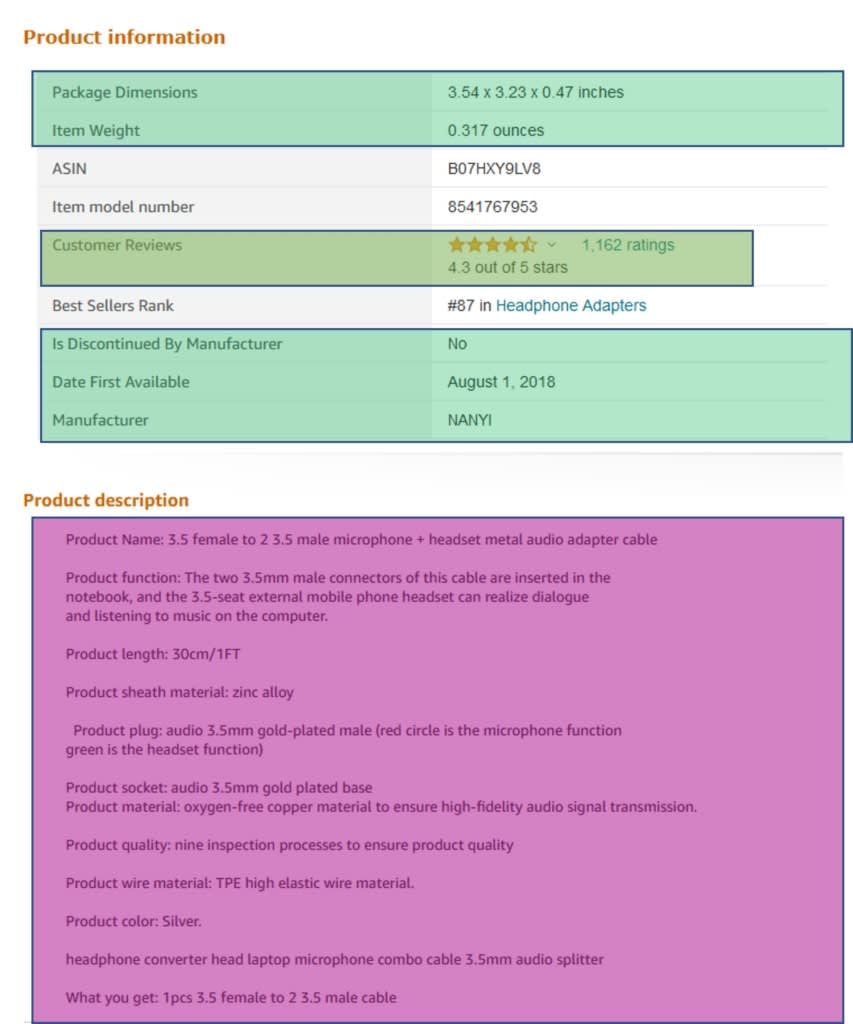
Product detail page below the fold, showing product information, customer reviews, and product description.
The elements listed here do not include paid ads, which occupy a significant amount of the real estate on both the Amazon search results page (SERP) and the product pages. They also don’t include additional information that is not (directly) in the seller's control, such as the Amazon Best Sellers rank.
Create optimal content for your Amazon listing
Now that we understand which content elements exist and how they are displayed to the user, we can get started with the first step: creating and enhancing your content. This means producing the different elements of product copy and your product images.
To begin with, our recommendation is to focus on the quality and relevance of the content, optimizing for click-through rate for the title and main image, and conversion rate for the other content elements. Starting with how the content reads from a user perspective, rather than making hardcore Amazon keyword optimization your first priority, is more likely to result in readable, meaningful content that fulfills your click-through and conversion rate goals.
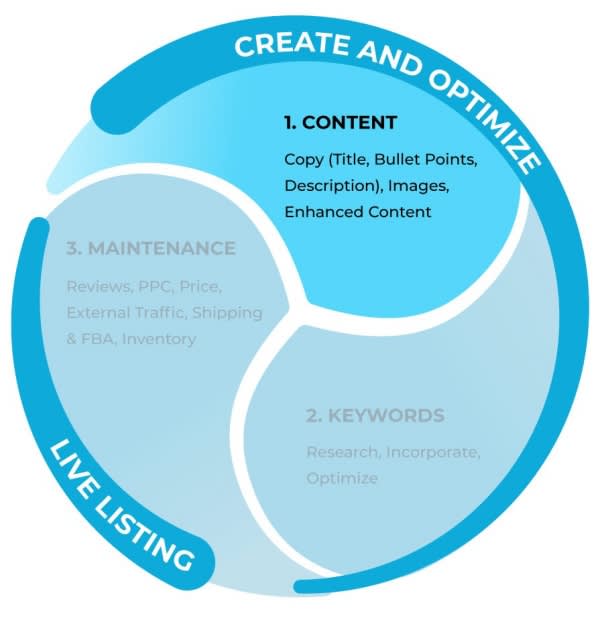
In addition to the positive impact on your organic Amazon rankings, improving the content of your product listings pages will likely benefit your conversion rate, which in turn will make your ads more competitive in Amazon’s ad auctions. One of the primary factors that determines the winner of a PPC ad auction is the product’s quality score — its click-through and conversion rates.
Top sellers use cutting-edge advertising tools
Perpetua offers the most advanced Amazon PPC solution on the market, with all the tools, resources, and expert support you need to build successful campaigns for your products. And what’s more, it couldn’t be easier to get started. Request a free demo today to discover the industry’s premier optimization and intelligence software for Amazon Ads.
Optimizing your product listings should, therefore, always be the first step to improve your ranking on Amazon.
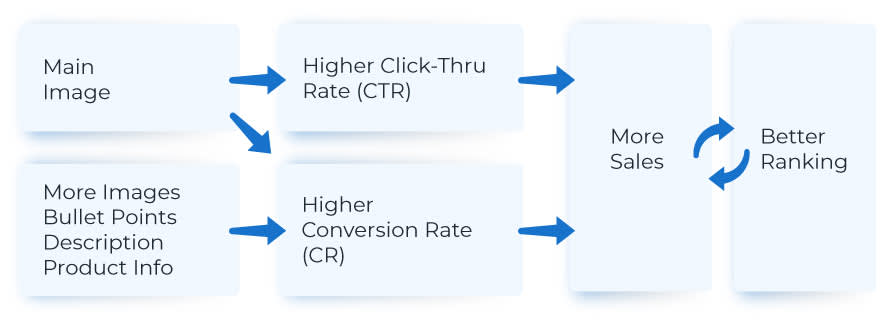
Optimizing your product copy and images improves your performance and rankings
Persuasive text that sells — how to write the best Amazon sales copy
Focus on optimizing the following product content for Amazon SEO:
Product title
Bullet points a.k.a. Highlights a.k.a. Attributes
Product description
Additional product information
Enhanced Brand Content (Sellers) & A+ Content (Vendors)
Note: Make sure you follow the Amazon Style Guides according to your product category. If you don’t, Amazon could suppress your product.
Download this handy ‘Quick Style Guide’ for basic guidelines that apply to all categories
Want to create convincing product texts? Stick to these basic rules.
Inform: Provide all information necessary for the purchase decision in the description
Sell: Highlight the benefits and USPs of your product in the description. Go beyond merely stating the features — tell your customers how your product can benefit them.
Present: Formally structure information so that the customer can scan it easily and quickly.
TIP: Pay Attention to Amazon Product ReviewsTo give your product texts an extra boost, go through the reviews and questions & answers for your product (or similar products). These segments often reveal what benefits and USPs are important to your customers and what information is crucial for their purchase decision.
Let’s have a look at each of these elements in turn.
Top sellers use cutting-edge advertising tools
Perpetua offers the most advanced Amazon PPC solution on the market, with all the tools, resources, and expert support you need to build successful campaigns for your products. And what’s more, it couldn’t be easier to get started. Request a free demo today to discover the industry’s premier optimization and intelligence software for Amazon Ads.
Can't wait to get started?
Content optimization tips
Here we run through some quick tips for optimizing the different content elements of your product listing.
Product title
The product title is the only piece of text content visible in the product preview, so this is something that will make or break your click-through rate.
Check the Amazon Style Guides for the length and structure of your title in the relevant product category
Impacts your click-through rate and conversion rate
Should contain important information, benefits, and USPs
Mobile view is limited to about 70 visible characters, so stick to the most important information and make sure to place it at the beginning.
Bullet points a.k.a. highlights a.k.a. attributes
Check the Amazon Style Guides for the relevant product category
Impacts your CR
Maximum 200 bytes (equivalent to approximately 200 characters) per bullet point (better: 150 bytes to support readability)
Outline the key features and benefits of the product
Always connect the features with the benefits for the customer (e.g. ‘easy to clean — the glass surface allows the kitchen scales to sparkle with a single wipe’)
Stick to one benefit per bullet point for better readability and information flow. For example: ��— Easy to Clean; Flexible Use etc.
Mobile view: Only the first three bullet points are directly visible to mobile users. Place your USPs at the beginning of the list.
Product description
The product description appears lower down on the page. However, users comparing your product with a competitor or seriously considering a purchase will likely look to the product description for details.
Check the Amazon Style Guides for the relevant product category
Impacts your conversion rate
Avoid duplicating the bullet points. Provide as much additional information as possible and tell a story about the product.
Make it easy to read.
Top sellers use cutting-edge advertising tools
Perpetua offers the most advanced Amazon PPC solution on the market, with all the tools, resources, and expert support you need to build successful campaigns for your products. And what’s more, it couldn’t be easier to get started. Request a free demo today to discover the industry’s premier optimization and intelligence software for Amazon Ads.
Additional product information
Additional product information is more technical than the product description, but no less important. Details provided here will be picked up by filters and/or appear in the relevant information fields.
Provide as much information as possible in the respective product information fields
Make sure that the information is correct — if your product is described as waterproof, but it isn't, that isn't going to help your business in the long run.
Impacts your conversion rate (additional product information appears in the product information sections of the product page).
Amazon’s search filters in the left-hand sidebar make use of the additional product information and can increase visibility. For example, if you provide information on color, size, and material then your product will show up when these filters are applied.
Pics that pop — create persuasive Amazon product images for Amazon SEO
Besides the text elements, your main and additional product images are also deserving of your time and attention when optimizing your product listings.
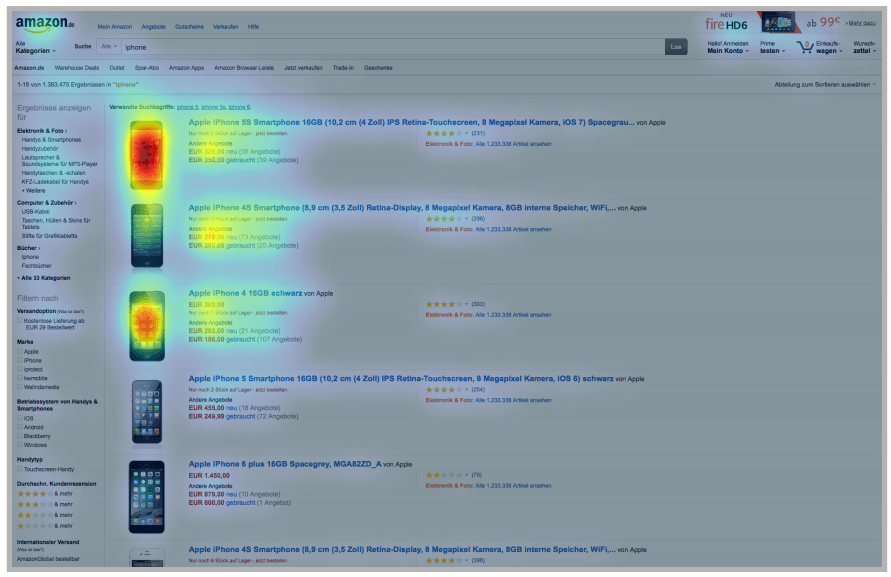
Why are product images important on Amazon?
Attractive, high-quality product images are immensely important for a product’s ranking because they can significantly improve the product’s performance (click-through rate, conversion rate, and sales).
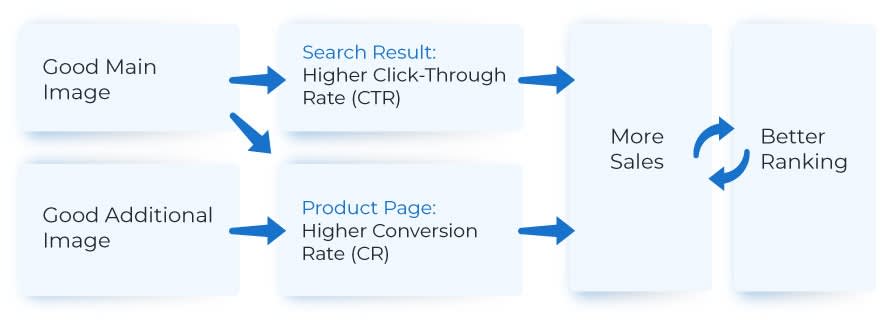
Step 1 — Search Results: The main product image in the search results is usually the first point of contact between your product and the customer. Shoppers click on a search result more frequently when it has an engaging main image. The main image is probably the most important factor for the click-through rate! Even more so than the product title. Additionally, an improved click-through rate will also lead to more sales for your product.
Step 2 — Product Page: Appealing product images can persuade customers to buy your product, thus improving your conversion rate and sales. Why? Good product images answer your customers' questions and give them all the information they need to make an informed buying decision — in a format that is easy to consume. Also, they leave a good impression and build trust with your buyers. Most customers, whether consciously or unconsciously, will follow simple purchasing logic: if the product image is bad, the product can’t be much better.
Note: Adding pictures and even including high-resolution images (to activate the zoom function) does not, however, lead directly to a better ranking. The number of pixels isn't one of the variables considered by the A9 algorithm. The product will only move up the ranks if the click-through rate, conversion rate, and sales also improve.
Top sellers use cutting-edge advertising tools
Perpetua offers the most advanced Amazon PPC solution on the market, with all the tools, resources, and expert support you need to build successful campaigns for your products. And what’s more, it couldn’t be easier to get started. Request a free demo today to discover the industry’s premier optimization and intelligence software for Amazon Ads.
What are the requirements for successful Amazon product images?
Just as product texts have both technical requirements and considerations regarding their content, the same is true of images.
1. Adhere to the minimum technical requirements
Amazon has specific minimum requirements that apply to all product images. If you don’t meet these basic requirements, Amazon could suppress the images or even the entire product.
Allowed formats: JPEG (preferred), TIFF, PNG, GIF
Color model: RGB (CMYK is for print, the colors will look different)
Resolution: Minimum 72 dpi
Additional technical requirements exist depending on the category, especially in the categories “Clothing” and “Shoes and Handbags.” Refer to the Amazon Style Guides for guidelines in the relevant product category.
2. Large enough to enable zoom
If possible, your images should always have a sufficiently high resolution to enable the zoom function (at least 1,000 pixels on the longest side, 500 pixels on the shortest side). Zoomable images aren't essential for Amazon accepting your product listing, but they will increase your conversion rate.
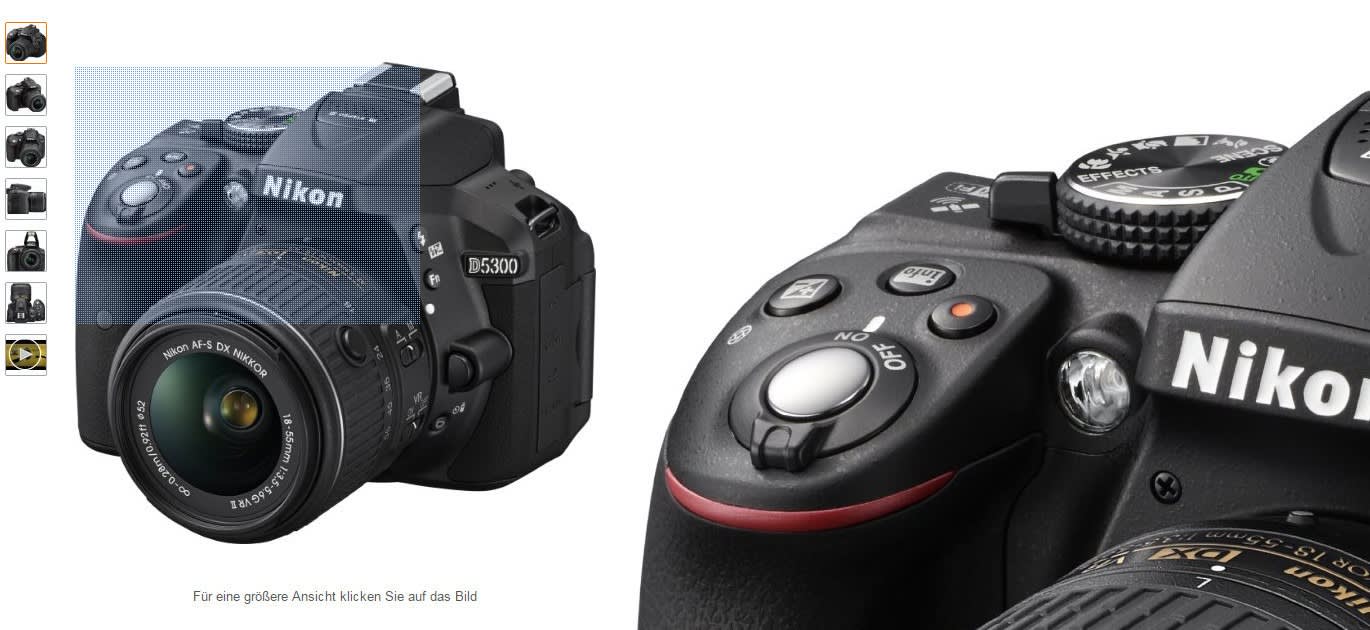
3. Extended options
360-degree view: Vendors have access to a 360-degree view, which allows customers to view some products from different angles. Contact Vendor Support to find out if this option is available to you.
Product video: Vendors can upload product videos. In the US marketplace, brand-registered sellers can also use Enhanced Brand Content to upload a product video in place of a product image.
Top sellers use cutting-edge advertising tools
Perpetua offers the most advanced Amazon PPC solution on the market, with all the tools, resources, and expert support you need to build successful campaigns for your products. And what’s more, it couldn’t be easier to get started. Request a free demo today to discover the industry’s premier optimization and intelligence software for Amazon Ads.
What makes a good main Amazon image?
The main image is the most important for the success or failure of your listing, as it appears in the organic search results (and will be used for any Sponsored Products ads you run for the product). The quality of the main image is, therefore, directly responsible for the number of clicks and therefore the number of people who will visit your product page
This makes it imperative that the main image displays the product in a way that is attractive to the customer, highlights its USPs, and makes it easy to recognize the product (the product should fill a large area of the image).
When selecting a main image, you should also consider the context in which it will be seen by potential buyers. They have typed in a search query and they see the image alongside the product title, without any further information. You should therefore ensure that your product title and image work well together and communicate a clear message to the Amazon shopper.To find the best main image for your product, consider A/B testing the click-though rates of different main images.

To do this, you can use Amazon Sponsored Products campaigns as they allow you to measure your click-through rates precisely, even for specific keywords. Even if they are measuring the click-through rate for a paid campaign, you can legitimately assume that a good main image in an ad will correspond to a good main image for an organic listing, as they are identical (except for the “Sponsored” flag).
Analyzing the click-through rate at keyword level can also help you to understand how the image matches the user expectations. It could be, for example, that a user searching for headphones will expect a different image to a user searching for earphones, even though your product might be relevant for both searches.
Use the free Benchmarker to compare your click-through rate to your peer group and get the insights you need to take your performance to the next level.
In addition to the requirements governing all images, main images also need to fulfill these criteria:
The image must only contain the core product — no accessories or props
The background must be pure white (RGB code: 255, 255, 255)
The product must fill 85% to 100% of the image area
Always show the product without packaging (with some exceptions, depending on the product)
The product must be fully visible
The main image must not contain text, graphics, or illustrations (only allowed in additional images).
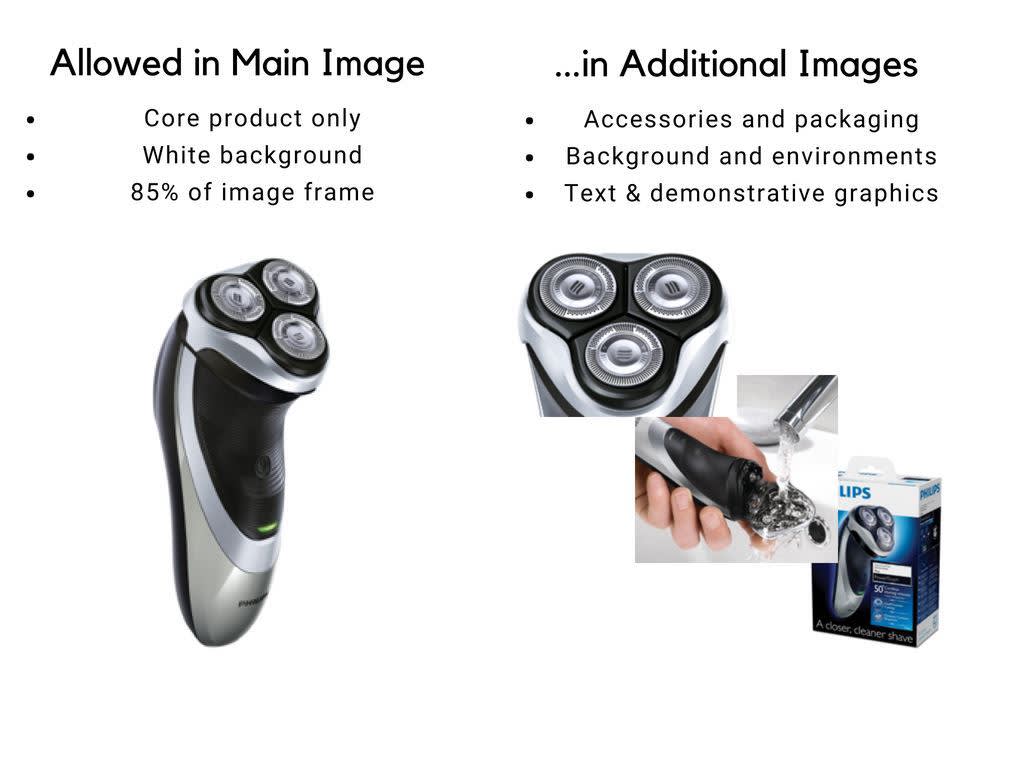
Additional images on your Amazon product detail page
(Remember: High-quality images on your product detail page improve your conversion rate (and, by extension, rankings) significantly. They compensate for the lack of direct contact with your product that a customer would have in an offline retail environment.You can (and should), therefore, use additional images to provide important information that your customer requires to make an informed buying decision and to showcase the benefits and USPs of your product.Get creative with the additional images. In contrast to the main image, these images allow you to add some extra depth with various backgrounds and props, for example.Depending on the product, you will need to highlight different aspects. Here’s how:): High-quality images on your product detail page improve your conversion rate (and, by extension, rankings) significantly. They compensate for the lack of direct contact with your product that a customer would have in an offline retail environment.
Top sellers use cutting-edge advertising tools
Perpetua offers the most advanced Amazon PPC solution on the market, with all the tools, resources, and expert support you need to build successful campaigns for your products. And what’s more, it couldn’t be easier to get started. Request a free demo today to discover the industry’s premier optimization and intelligence software for Amazon Ads.
You can (and should), therefore, use additional images to provide important information that your customer requires to make an informed buying decision and to showcase the benefits and USPs of your product.
Get creative with the additional images. In contrast to the main image, these images allow you to add some extra depth with various backgrounds and props, for example.
Depending on the product, you will need to highlight different aspects. Here’s how:

Brand-only features — Amazon A+ Content and Enhanced Brand Content
Amazon Enhanced Brand Content and A+ Content are extended content features for brand-registered Sellers and Vendors, respectively.
With various layouts (a.k.a. modules) and an easy-to-use content tool to create appealing texts and vivid images, these enhancements can give your standard product description page a significant visual boost.
Enhanced content allows you to answer your buyer’s questions conclusively and in a more engaging way. Good enhanced content can, therefore, lead to a better conversion rate, more sales, and better reviews, as the customer's expectations are more likely to be fulfilled.
According to Amazon, enhanced content can increase your sales by 3-10% through a higher conversion rate. This means that you can afford to pay more per click, as each click is more valuable (i.e., increased RoAS, lowered ACoS).
Remember: Even an increase of a few percent in the conversion rate can make a huge difference!

What are the advantages of enhanced content (for sellers and vendors)?
Product story: More images and elaborate product descriptions give you the space to tell your product’s story in a more engaging way. Use it to show off unique benefits and features, as well as the lifestyle connected to your product.
Brand awareness: Telling your brand’s story and connecting with your buyers builds brand awareness and loyalty. It differentiates you from the competition and can encourage repeat purchases.
Product range: Comparison charts help users to discover more of your products and make better buying decisions. They also decrease the probability that users get distracted and led (detoured) tocompetitor products — for example, by Sponsored Products ads or Amazon’s “similar product” comparison widget.
Top sellers use cutting-edge advertising tools
Perpetua offers the most advanced Amazon PPC solution on the market, with all the tools, resources, and expert support you need to build successful campaigns for your products. And what’s more, it couldn’t be easier to get started. Request a free demo today to discover the industry’s premier optimization and intelligence software for Amazon Ads.
Enhanced Brand Content is free for Sellers, but it is only available if you have registered your brand with Amazon and you are on a professional selling plan.
Basic A+ Content is also free for vendors. The paid version, “Premium A+ Content,” offers more interactive options such as video and slider carousels, but it is an exclusive program and only available by invitation from your vendor manager. It also comes at a steep cost.
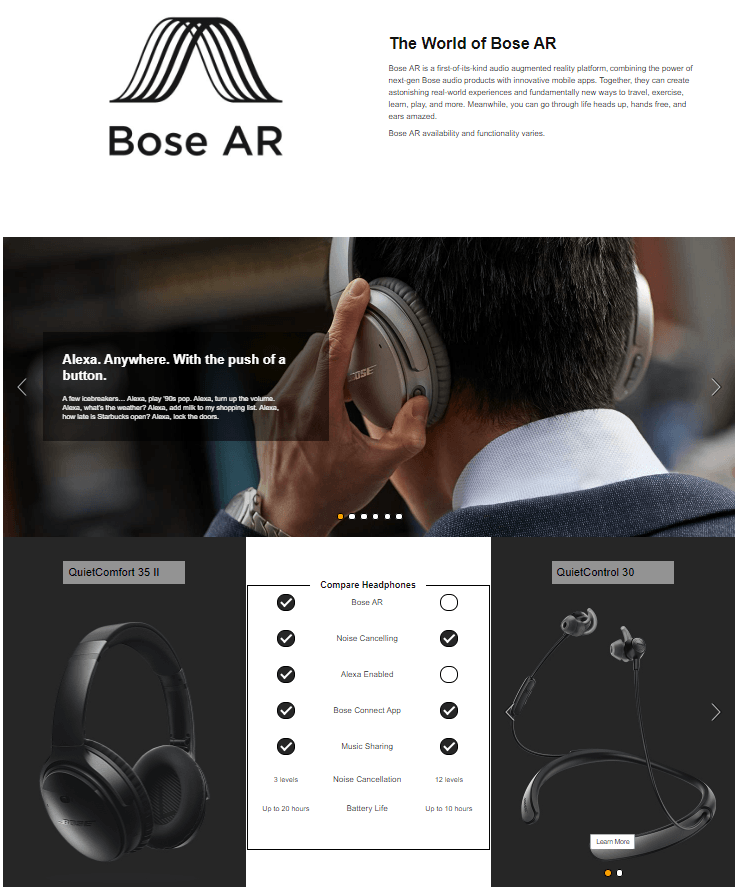
When should I use enhanced content?
Since all branded ASINs are eligible and the basic features are free to use, you can aim to add enhanced content to all your products.
Bear in mind, however, that you still have to invest time and effort into the creation of Enhanced Brand/Marketing Content.
Also, Amazon Brand Registration is free, but you need to officially register your brand as a trademark to be eligible — which comes at a cost.
Enhanced content is not indexed by Amazon and therefore doesn’t directly increase visibility in search results. Enhanced content can, however, improve rankings indirectly by improving the conversion rate.
Note: As enhanced content isn't indexed, you should ensure that your keywords appear in the indexed content elements like your bullet points. Otherwise, your product listing won't rank and no one will see your enhanced content, however beautiful and descriptive it might be.
Enhanced content is also not an easy fix for a product that isn’t selling well. On the contrary, enhanced content is an accelerator for a product that is already performing strongly on Amazon.
How to optimize keywords for Amazon SEO
In the first step, you’ve written your listing and created compelling product content to convince customers to click and buy your product. Your content will enhance your product’s performance and improve its rankings.
But wait, wasn’t there another essential item? That’s right — keywords. The right keywords will allow your product to appear in the search results in the first place. So now, in the second step, let’s add some keywords to your listing and optimize them.
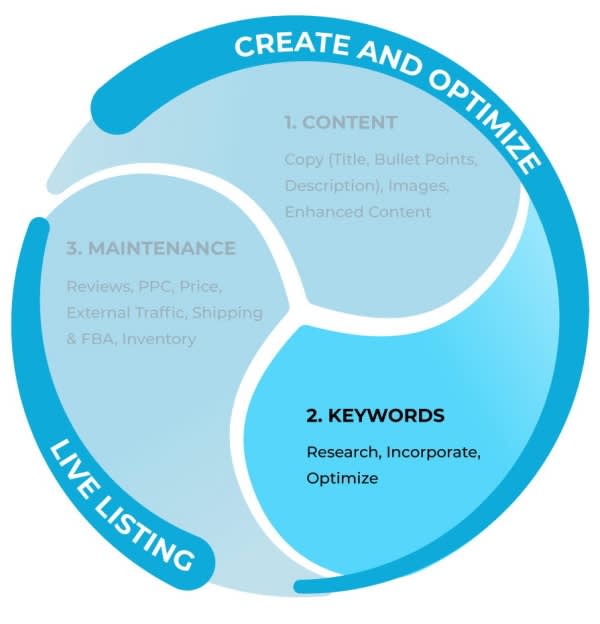
How to conduct Amazon keyword research
Remember: Shoppers can only find your product on Amazon if your product page contains all the keywords that shoppers use in their search query. Your first step in keyword optimization is, therefore, to identify all relevant keywords. Here are some techniques and tools to do that.
Top sellers use cutting-edge advertising tools
Perpetua offers the most advanced Amazon PPC solution on the market, with all the tools, resources, and expert support you need to build successful campaigns for your products. And what’s more, it couldn’t be easier to get started. Request a free demo today to discover the industry’s premier optimization and intelligence software for Amazon Ads.
Amazon autocomplete
When you enter a keyword in the Amazon search box, autocomplete suggests search terms that Amazon customers use frequently.
Autocomplete is a valuable source of keywords based on searches conducted by real Amazon customers.
For example, entering a keyword followed by the letters A to Z allows you to search for a whole series of different combinations.
Competitor listings
Analyze your competitors’ listings to find an array of relevant keywords.
To do this, enter one of the main keywords for your product in the Amazon search and analyze the top products on the search results page.
Customer reviews
Take a close look at the reviews shoppers left on your and similar products. You will discover the exact terms buyers use to describe your product.
Sonar — the free Amazon keyword research tool
Sonar is a free keyword research tool designed explicitly for Amazon. Sonar contains a database of millions of real Amazon search queries. Type in anything to find a list of matching keywords, then download and use them for your Amazon SEO.
Sonar even displays the Amazon search volume for each of the keywords. You can also research keywords selectively for each European Amazon marketplace (DE, UK, FR, IT, ES) and for Amazon.com (US).
Is keyword research too time consuming?
Perpetua can automate the keyword optimization for your campaigns. You simply choose between an automatic or custom threshold for conversions - our software takes care of the rest. Check it out!
How to add keywords to your Amazon product listing
Now that you have identified the relevant keywords, how do you use them to optimize your product listing?
Since a product listing must contain the relevant keyword for the product to appear in Amazon’s search results, the most basic rule of keyword optimization is straightforward:
Include all relevant keywords in your listing.
Where should I put my keywords? Amazon product listing fields and their indexation
The next important question is: where should I put the keywords?
Amazon’s A9 algorithm looks at the keywords in various fields in your product listing to determine if your product can show up for a shopper’s search term. If your product can show up in search results for a specific keyword, then your product is indexed for this keyword.
Top sellers use cutting-edge advertising tools
Perpetua offers the most advanced Amazon PPC solution on the market, with all the tools, resources, and expert support you need to build successful campaigns for your products. And what’s more, it couldn’t be easier to get started. Request a free demo today to discover the industry’s premier optimization and intelligence software for Amazon Ads.
Let’s take a closer look at how Amazon treats the keywords in each of those fields in your product listing.
FIELD | INDEXED? |
|---|---|
Brand | Yes |
Title | Yes |
Bullet Points (“Highlights”) | Yes (1st 1000 bytes) |
Description | Limited |
A+ Content & Enhanced Brand Content | No |
Backend Keywords (“Generic Keywords”) | Yes (up to 249 bytes) |
Further Keyword Fields (e.g., “Target Audience Keywords”) | Yes (for search filter) |
Product Information Fields (e.g., “material”) | Yes (for search filter) |
Note on Bytes vs. Characters: we deliberately distinguish between bytes and characters to refer to different length restrictions and indexing limits of fields in the product listing. While regular characters/letters from A-Z are 1 byte in size, special characters such as ä, ü, ö, é are 2 or more bytes in size.
Weighting of the different fields: does it matter where I put my keywords?
The fields of the product listing (title, bullet points, description, backend keywords, etc.) used to be weighted differently in the Amazon ranking algorithm. Amazon removed this weighting in October 2018.
Currently, the fields are weighted equally. It doesn’t matter where you put your keywords, as long they’re in a field that’s indexed.
Brand
Even though your brand is indexed as a keyword, it does not (and cannot) vary across product listings and, therefore, offers no opportunity for optimization.
Title
The product title is fully indexed for search. Use the category-specific Amazon Style Guides to determine the correct title length for your product.
Make sure you get this right. Amazon rejects overlong titles and even suppresses listings in certain circumstances. If this happens, your product will no longer appear in the search results.
Bullet points (highlights)
In some categories, Amazon only indexes the first 1,000 bytes (including spaces) of the whole bullet point section. Keywords after this threshold are not indexed.
That said, the text should normally be shorter anyway. Being more concise keeps the bullet points readable and avoids adverse effects on the conversion rate. We therefore recommend aiming for no more than 150 bytes per bullet point, which would keep you well under the 1,000 byte threshold.
Our recommendation: Use 200 bytes maximum per bullet point (better 150 bytes) to guarantee full indexation and a good conversion rate.
If, in exceptional circumstances, you simply cannot avoid your total bullet point length exceeding 1,000 bytes, then at least ensure that your most important keywords are included in the first bullet points so that these will be found in the content that is indexed.
Top sellers use cutting-edge advertising tools
Perpetua offers the most advanced Amazon PPC solution on the market, with all the tools, resources, and expert support you need to build successful campaigns for your products. And what’s more, it couldn’t be easier to get started. Request a free demo today to discover the industry’s premier optimization and intelligence software for Amazon Ads.
Product description
Whether or not a product description is indexed depends on the category of your product.
In some categories, products can be found via all the keywords in the product description. In most categories, however, the following is true:
A product DOES NOT appear in the search results when customers search for a single keyword from the product description that is not in any other indexed field
A product DOES appear in the search results when:
a) customers search for two or more keywords from the product description that are located close to each other or
b) customers search for a keyword from the product description AND at least two other keywords from one or more indexed fields (i.e. title, bullet points, backend keywords)
The product description is therefore an excellent place to add your long-tail keywords.
Is keyword research too time consuming?
Perpetua can automate the keyword optimization for your campaigns. You simply choose between an automatic or custom threshold for conversions - our software takes care of the rest. Check it out!
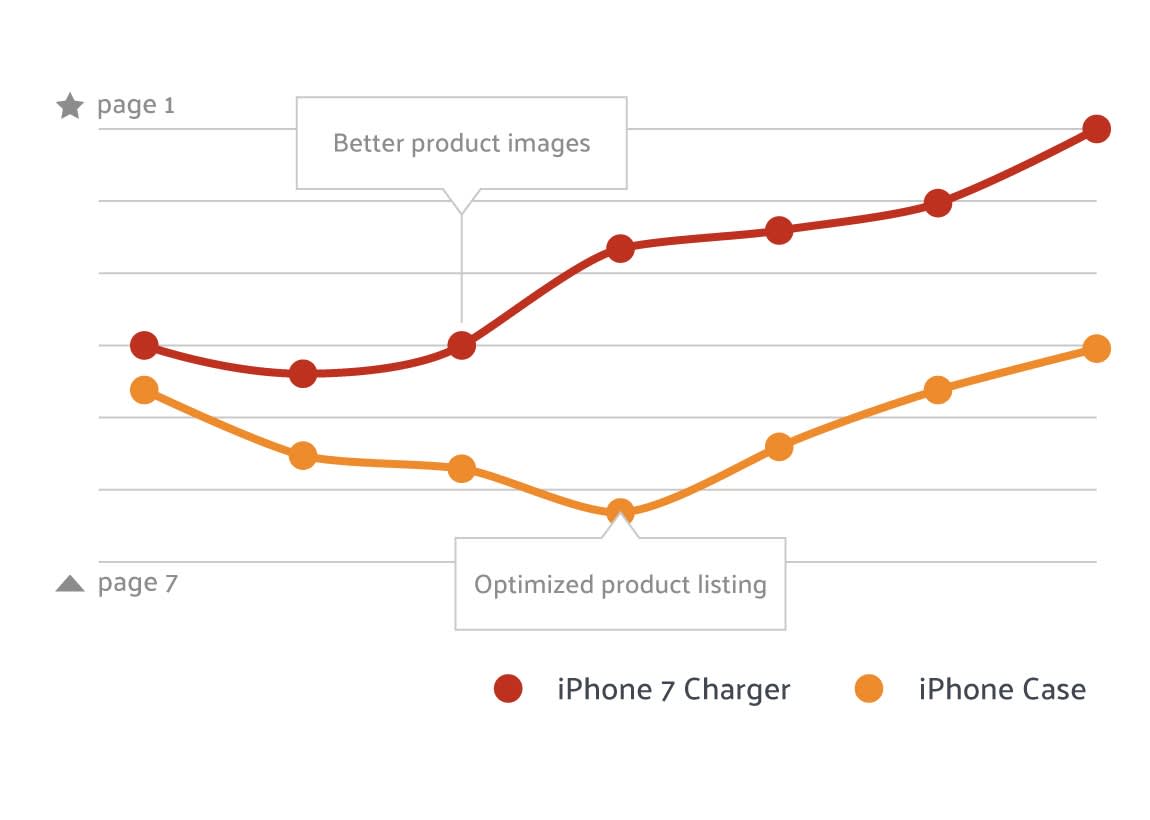
Finally, the product description is also relevant for Google SEO. Due to the limited indexation, however, our recommendations remain. Particularly as more product searches begin on Amazon than Google, your Amazon SEO efforts should be focused primarily on optimizing for Amazon's A9 algorithm, and not for Google search.
Enhanced Brand/Marketing A+ Content
As mentioned above, Amazon does not index enhanced content (A+ for vendors and Enhanced Brand Content (EBC) for sellers) for search. If the relevant keywords only occur in enhanced content, the product will not appear in the search results.
Enhanced Content vs. Product Description
When it comes to indexing and conversion optimization, the regular product description and the enhanced content offer contrasting features and benefits.
Enhanced content is visually pleasing, but the regular product description can be indexed. While A+ Content for vendors is additional eye-candy, EBC for sellers replaces the regular product description. You might, therefore, ask yourself:
Should I focus more on the product description or enhanced content?
If you have to choose between the two, we recommend focusing on enhanced content. The product description is not that important for your Amazon SEO strategy.
One reason for this low priority is the limited indexation we mentioned, as well as the possibility to cover all relevant keywords in your backend keywords, title, and bullet points.
Top sellers use cutting-edge advertising tools
Perpetua offers the most advanced Amazon PPC solution on the market, with all the tools, resources, and expert support you need to build successful campaigns for your products. And what’s more, it couldn’t be easier to get started. Request a free demo today to discover the industry’s premier optimization and intelligence software for Amazon Ads.
Once you have your keywords covered, conversion optimization becomes your main goal. Enhanced content offers better tools for creating engaging and convincing content and is — just like the product description — also indexed by Google.
Backend keywords (a.k.a. search terms/generic keywords)
The backend keyword indexation limit is currently 249 bytes, including spaces and punctuation.
Vendors — please note: The generic keywords fields for vendors do not have a byte counter showing whether you have exceeded the limit. If the total byte count across your generic keyword fields goes over 249 bytes, including spaces and punctuation, none of your keywords will be indexed.
**Sellers — please note**: The search terms/generic keywords field has an integrated byte counter. This byte counter does NOT count spaces and certain punctuation (, . ;). These ARE, however, (currently) counted for indexation. If you use the total character length permitted by the byte counter, you might actually exceed 249 bytes (including spaces and punctuation), and some of your keywords may not be indexed. Your first keywords within the limit will, however, be indexed.
Additional product and keyword fields
You can add further information (e.g., about materials) in the additional product fields. For some products, you can define additional keyword types, such as target audience keywords (e.g., man, woman).
Make sure you get the most out of these fields, as the information provided can be used for search filters (sidebar navigation in the search results) and product finders.
Amazon SEO keyword rules — how Amazon treats keywords
Finally, to add your keywords efficiently, you should adhere to some general keyword rules. Stick to the following guidelines to optimize the formatting of your keywords:
You don’t have to repeat keywords (e.g., in your backend keywords, use “wallet men leather” instead of “wallet men wallet leather”). Repetition has no positive impact on ranking. Instead, use the valuable space to add more relevant keywords.
Use either singular or plural. Adding both is not necessary. The exception: long compound words in German (e.g., Mehrzweckregal, Fitnessarmbänder)
Capitalizing letters (or not) is irrelevant.
Umlaute (ü, ä, ö) are matched to ue, ae, oe. Adding both versions is not necessary.
Accents (entrecôte, roségold, mèches) are matched to the non-accent spelling (entrecote, rosegold, meches). Adding both versions is not necessary.
Minor misspellings (carreirbag, runnign shoe, laether wallet) are matched to the same as the correct spelling. Adding both versions is not necessary.
Different spellings of compound words (fitnessball vs. fitness ball, flipchart vs. flip chart) are not indexed automatically. You have to include both versions or use hyphens (see next bullet point).
You can cover different variations by joining or separating words through hyphens, e.g., A-B ranks for A, B, A B, AB, A-B (use for max. 2 words, e.g. flip-chart)We at regularly test Amazon’s SEO ranking algorithm and publish our results in our algorithm update posts.
Top sellers use cutting-edge advertising tools
Perpetua offers the most advanced Amazon PPC solution on the market, with all the tools, resources, and expert support you need to build successful campaigns for your products. And what’s more, it couldn’t be easier to get started. Request a free demo today to discover the industry’s premier optimization and intelligence software for Amazon Ads.
Workflow for your Amazon keyword optimization
Now that we’ve covered all the important information on keyword optimization, let’s get to the concrete workflow. After all this theory, you still might ask yourself:
How do I optimize Keywords on Amazon?
We recommend the following Amazon keyword optimization workflow:
Step 1 — Optimize backend keywords
Place as many keywords as possible in the backend keyword field (also called “search terms,” or “generic keywords”) before adding keywords to your content. This practice will keep your content highly readable. For vendors and sellers, as mentioned above, to get all of your keywords indexed, don’t use more than 249 bytes (including spaces and punctuation). Use spaces (sellers) or commas/semicolons (vendors) to separate your backend keywords and remember the general keyword rules.
Step 2 — Place remaining keywords in the product content (i.e., title, bullet points, product description)
Always keep readability and the user experience in mind when adding your keywords. You do not have to add the keywords you already covered in the backend to your product content. In terms of Amazon SEO strategy, repeating the keywords in different locations has neither a negative nor a positive effect on ranking.
Step 3 — Fill in additional product and keyword fields
We already mentioned that additional product and keyword fields can improve the searchability and visibility of products through Amazon search filters (page navigation). You should, therefore, try to fill in these fields as completely as possible.
Amazon keyword optimization FAQ
Here we address some of the most frequently asked questions on the topic of Amazon keyword optimization. For the other aspects of SEO, see the Amazon SEO FAQ later in this article.
Which field ranks best? Where should I place my main keywords?
It’s true: Amazon keyword fields used to be weighted. There was, for example, a slight positive ranking effect for products that contained a keyword in the title. Amazon has, however, removed this weighting.
As long as you enter the keyword in an indexed field, it makes no difference where you place it in your listing. Instead, Amazon now relies even more on the keyword-specific performance of a product (click-through rate, conversion rate, sales, etc.).
The focus now lies on readability: Instead of stuffing keywords (especially in the title), Amazon wants you to focus on conversion-optimized content that complies with their guidelines.
Should I repeat my keywords to rank higher for them?
No. Keyword repetition shows no positive impact on ranking. Use the space to add more relevant keywords. You should only repeat a keyword if it makes sense from a content perspective (e.g., to emphasize a particular USP you might have the word “lightweight” in the title and the bullet points).
How can I track my Amazon keyword rankings?
Manually monitoring where your products rank for all relevant keywords is impossible at any kind of scale and an inefficient use of your time. We therefore recommend using an automated Amazon ranking tracking software that will alert you to any significant changes in rankings and help you evaluate the success of any keyword optimization measures you conduct.
Top sellers use cutting-edge advertising tools
Perpetua offers the most advanced Amazon PPC solution on the market, with all the tools, resources, and expert support you need to build successful campaigns for your products. And what’s more, it couldn’t be easier to get started. Request a free demo today to discover the industry’s premier optimization and intelligence software for Amazon Ads.
Can I increase the number of indexed keywords by spreading them across variants?
Kind of. The main rule still applies: your listing must contain the relevant keywords for buyers to find it — but if you’re pressed for space, there is a workaround.
A parent listing will automatically update all child listings with its bullet points, description, and backend keywords. That means you can feed the parent listing a basic set of primary keywords, and its child ASINs will rank for them, too.
In a second step, you can now add long-tail keywords that are specific to each child ASIN. This way, you increase the total number of possible keywords — and the chances that shoppers find at least one of your variants.
As soon as they open it, they will also see the other variants that previously weren’t displayed in the search results.
Ongoing optimization: how to keep improving your rankings
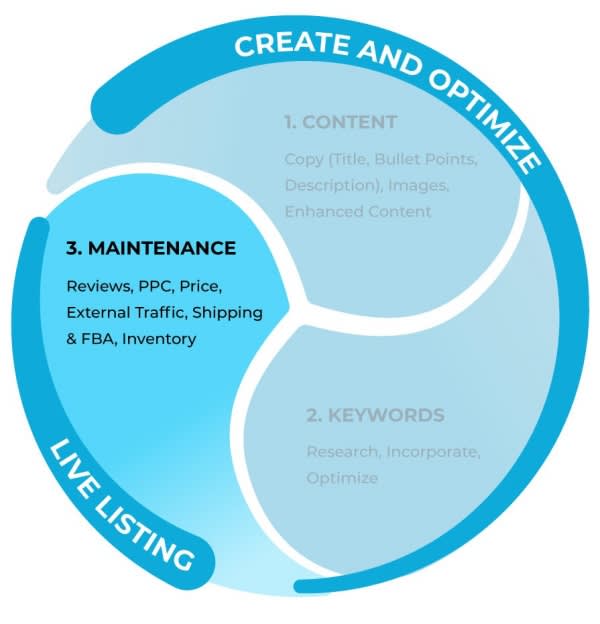
Congratulations! You’ve now optimized the content and keywords of your listing and can publish it. Instead of just waiting for the sales to roll in, however, you should engage in ongoing optimization to improve your rankings and maximize your success.
In general, you should always keep an eye on your product listing, to make sure it’s up to date, still performing well, and hasn’t been hijacked.
Additionally, there are some other important levers that you can continuously optimize to improve your rankings:
Let’s take a look at them.
Dealing with customer reviews and questions
The first lever is how you respond and manage customer reviews and questions about your products.

How Amazon reviews influence your ranking
Reviews are critical to the click-through rate, conversion rate, and sales of a product and, therefore, to how well it ranks. Customers often scroll straight down to read the feedback left by previous buyers. The more positive reviews your product has, the better it will perform. Thus, there are two aspects to take care of:
Number of product reviews
Product review score (star rating)
How to increase your number of Amazon reviews
You can increase your number of reviews in various ways. In general, a customer’s willingness to submit a review increases with excellent customer service. You could also use parcel inserts to prompt customers for reviews or advertise on product testing platforms.
Always make sure you stay within the review guidelines of Amazon, especially with the latter method. If you are found to be in breach of the guidelines, Amazon could remove your product listings completely.
How to increase your product rating
Make sure you engage with your reviews regularly to maintain a high product rating. As a merchant or manufacturer, it used to be possible to comment directly on customer reviews, but Amazon removed this feature, making it harder for you to add your perspective for other readers.
Top sellers use cutting-edge advertising tools
Perpetua offers the most advanced Amazon PPC solution on the market, with all the tools, resources, and expert support you need to build successful campaigns for your products. And what’s more, it couldn’t be easier to get started. Request a free demo today to discover the industry’s premier optimization and intelligence software for Amazon Ads.
However, you can still learn where customers' pain points are by reading the reviews and addressing these issues in the content of your product listing. Often, a bad review won't be because of a bad product, but because the buyer feels misled by the product description. Of course, if customer reviews do contain legitimate complaints about the quality of your product, then you can use these to guide your product development.
Updating your content to avoid misunderstandings can pre-empt future negative reviews. This practice helps you to keep your conversion rate up for future customers. It also shows excellent customer service and might persuade the customer to amend the review or remove it altogether (read more here: how to deal with negative reviews).
Did you know?
Amazon also offers vendors and sellers its own fee-based programs for generating reviews: Amazon Vine and the Early Reviewer Program, respectively.
Answering Amazon customer questions and answers
The questions that customers can ask on the product page are just as important, and these still give you, as the seller, an opportunity to respond directly to your (potential) customers. Shoppers often ask about specific details they can’t find on the product page. Sellers, vendors, and other customers can answer questions.
If you're the seller or vendor, it's important that you address unanswered questions regularly to ensure that customers receive correct answers. Doing so will also improve the information content of the product page: questions, like (negative) reviews, can often point to more significant information gaps, which you can also add to your product description or bullet points.
Boost Amazon SEO with Amazon PPC (and other promotions)
Another tool you have to improve your Amazon SEO is promoting your products via Amazon PPC.

Successful Amazon advertising requires an optimal Amazon SEO strategy
Amazon ad placements are decided based on a PPC auction, but there is an important underlying aspect: relevance. In many cases, Amazon will only display your ad if your product page also contains your targeted keyword. PPC (Pay-Per-Click) campaigns can, therefore, only work if you optimize your product listing for relevant keywords first — using Amazon SEO.
Ensuring you have the right keywords covered is a bit like signing up for the auction in the first place. If you're not eligible to compete, then you stand a zero chance of winning.
Bonus: Optimizing your product page for click-through rate and conversion rate will also improve the performance of your advertising campaigns. Once a user is on the product page, it makes no difference to them whether they have clicked on an ad or an organic search result, so the same conversion rate criteria apply.
Amazon PPC improves the organic ranking of your product
But now the important part for your rankings: the organic ranking of a product depends immensely on its performance, in particular how well it sells. Unlike Google AdWords, this also applies to sales that derive from Amazon PPC campaigns.
An increase in sales due to PPC improves the overall performance of the product and, in turn, the organic ranking.
Top sellers use cutting-edge advertising tools
Perpetua offers the most advanced Amazon PPC solution on the market, with all the tools, resources, and expert support you need to build successful campaigns for your products. And what’s more, it couldn’t be easier to get started. Request a free demo today to discover the industry’s premier optimization and intelligence software for Amazon Ads.
This feedback mechanism is especially helpful when looking to improve the organic visibility of new products, a process that would otherwise take much longer.
Want to know more about Amazon Advertising?
Find our beginner and advanced guides here:
Already using Amazon PPC ads?
If you're already advertising on Amazon, you can compare all your most important KPIs with your competitors with our free Benchmarker tool. It gives you a product-by-product breakdown of your advertising performance, as well as the key metrics for your whole account. Get an edge on the competition with the Benchmarker today!
Price — A/B test your prices
As analyses we've conducted have shown, cheap products are not especially favored by Amazon’s ranking algorithm. That means you don’t need to have the cheapest product around to be successful on Amazon.
You still need a competitive price, of course. Your price will impact your ranking because it will influence:
Click-through rate in search results: customers compare your price to the other products in the search results when choosing which products to click on.
Conversion rate and sales on the product page: does your price match your target audience, product quality, branding, etc. to be able to achieve a good conversion rate?
Defining a good price using a theoretical approach can be very tricky. This is why you should A/B test different prices and compare the results in terms of click-through rate, conversion rate, sales and, of course, profit.
You should also check the search results for your main keywords regularly, as even if you don't change your price, your competitors may have changed theirs. Or new products could be ranking above/below yours that have a significantly lower price point. This means that your click-through rates (and sales!) can be affected, even when you don't do anything.
External traffic — create additional traffic and sales for your Amazon listing
Using external traffic means directing customers from external sites to your product on Amazon to create additional traffic and sales that will also improve your rankings.
This effect on rankings can be a good reason to send traffic to Amazon rather than to your online shop.
Useful landing pages to direct traffic to are product pages, product selection pages or, if you have one, your Amazon Brand Store.

Here are some ways of generating external traffic:
Pay-per-click advertising (Google Adwords, Facebook ads etc.)
Newsletter/emails
Content/influencer marketing (promote your product on blogs, YouTube, forums, etc.)
Social media (e.g., brand pages)
Send traffic from your online shop to Amazon
Find more information about using external traffic in our Amazon marketing overview.
Shipping and FBA (fulfillment by Amazon)
If you don’t use FBA yet, you should consider it, because FBA is needed for your product to be available with Prime shipping (unless you use “Seller Fulfilled Prime”).
Only with Prime shipping, in turn, will you be able to realize a significant number of sales from the constantly growing number of Prime members.
Top sellers use cutting-edge advertising tools
Perpetua offers the most advanced Amazon PPC solution on the market, with all the tools, resources, and expert support you need to build successful campaigns for your products. And what’s more, it couldn’t be easier to get started. Request a free demo today to discover the industry’s premier optimization and intelligence software for Amazon Ads.
Unless you have the Prime label, Prime members are unlikely to even click on your product because the Prime label already appears in the search results.
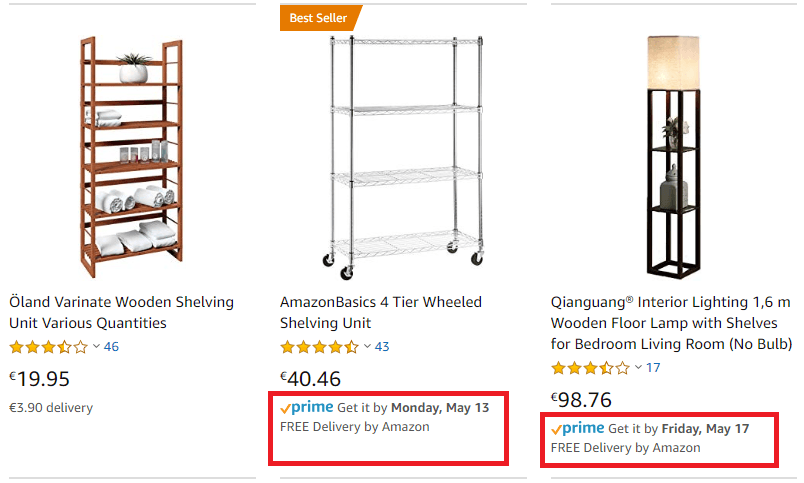
Prime members can even filter out non-Prime products in the search results.

Inventory management — don’t run out of stock
Running out of stock might or might not hurt your rankings — depending on how long you are out of stock and how you deal with the situation. The longer you are out of stock, the higher the chances that you will experience a significant drop in rankings.
If you know that you will go out of stock, here are two tips from our out-of-stock case study:
Don’t raise your prices (significantly): this will hurt your click-through rate, conversion rate, and sales, and as a consequence it will definitely hurt your rankings.
Use Amazon Advertising to recover rankings: after restocking, use Amazon Advertising to generate sales quickly and increase your rankings again.
Amazon SEO: The Bottom Line About How to Rank on Amazon
You just read the most comprehensive guide to Amazon SEO strategy out there. We made sure to include everything there is to know — so that you never feel overrun with ambiguous information ever again.
So what’s next?
First: Download our Amazon SEO checklist! In our checklist, we've boiled down all the vast information to the essentials you need for optimizing your listing step-by-step.
Then, check your best-selling listings (and then your poor performers). Identify the elements we discussed in this guide. Can you give them a boost?
If you continue to maximize your success, you will grow and add more products. You will encounter new challenges — from effective advertising to making smart business decisions based on your sales performance and revenue growth.
Top sellers use cutting-edge advertising tools
Perpetua offers the most advanced Amazon PPC solution on the market, with all the tools, resources, and expert support you need to build successful campaigns for your products. And what’s more, it couldn’t be easier to get started. Request a free demo today to discover the industry’s premier optimization and intelligence software for Amazon Ads.
It’s a good idea to be prepared — the easiest way to stay in control of your entire journey as a seller on Amazon is by using Perpetua.
Top sellers use cutting-edge advertising tools
Perpetua offers the most advanced Amazon PPC solution on the market, with all the tools, resources, and expert support you need to build successful campaigns for your products. And what's more, it couldn't be easier to get started. Request a free demo today to discover the industry's premier optimization and intelligence software for Amazon Ads.
Amazon SEO FAQ
Is there SEO for Amazon?
How can sellers improve their Amazon SEO?
How can sellers improve their Amazon SEO?
Does Amazon SEO also work with Google SEO?
Does Amazon A+ content affect SEO?
How do I maximize my SEO on Amazon?
To get started or learn more about how Perpetua can help you scale your Amazon Advertising business, contact us at hello@perpetua.io